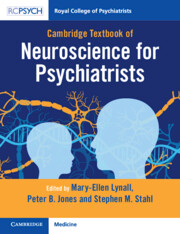Book contents
- Cambridge Textbook Of Neuroscience for Psychiatrists
- Reviews
- Cambridge Textbook of Neuroscience for Psychiatrists
- Copyright page
- Contents
- Contributors
- Introduction
- 1 Cells
- 2 Neurotransmitters and Receptors
- 3 Basic Techniques in Neuroscience
- 4 Neuroanatomy
- 5 Neural Circuits
- 5.1 Appetite
- 5.2 Sleep
- 5.3 Sex and Sex Hormones
- 5.4 Violence and Aggression
- 5.5 Nociception and Pain
- 5.6 The Motor System and Movement Disorders
- 5.7 Computational Models of Learning
- 5.8 Habit Formation
- 5.9 Reward, Pleasure and Motivation
- 5.10 Emotion
- 5.11 Perception
- 5.12 Attention
- 5.13 Apathy, Anhedonia and Fatigue
- 5.14 Memory
- 5.15 Fronto-Executive Functions
- 5.16 Empathy and Theory of Mind
- 5.17 Language
- 5.18 Brain Networks and Dysconnectivity
- 6 Modulators
- 7 Genetics
- 8 Neurodevelopment and Neuroplasticity
- 9 Integrated Neurobiology of Specific Syndromes and Treatments
- 10 Neurodegeneration
- Index
- References
5.13 - Apathy, Anhedonia and Fatigue
from 5 - Neural Circuits
Published online by Cambridge University Press: 08 November 2023
- Cambridge Textbook Of Neuroscience for Psychiatrists
- Reviews
- Cambridge Textbook of Neuroscience for Psychiatrists
- Copyright page
- Contents
- Contributors
- Introduction
- 1 Cells
- 2 Neurotransmitters and Receptors
- 3 Basic Techniques in Neuroscience
- 4 Neuroanatomy
- 5 Neural Circuits
- 5.1 Appetite
- 5.2 Sleep
- 5.3 Sex and Sex Hormones
- 5.4 Violence and Aggression
- 5.5 Nociception and Pain
- 5.6 The Motor System and Movement Disorders
- 5.7 Computational Models of Learning
- 5.8 Habit Formation
- 5.9 Reward, Pleasure and Motivation
- 5.10 Emotion
- 5.11 Perception
- 5.12 Attention
- 5.13 Apathy, Anhedonia and Fatigue
- 5.14 Memory
- 5.15 Fronto-Executive Functions
- 5.16 Empathy and Theory of Mind
- 5.17 Language
- 5.18 Brain Networks and Dysconnectivity
- 6 Modulators
- 7 Genetics
- 8 Neurodevelopment and Neuroplasticity
- 9 Integrated Neurobiology of Specific Syndromes and Treatments
- 10 Neurodegeneration
- Index
- References
Summary
Motivation – the capacity to experience enthusiasm for achieving a goal, which helps to initiate, guide and maintain behaviour – is a fundamental psychological process that serves to enable both survival and thriving in the face of challenge. Loss of motivation can have a debilitating impact on everyday function, resulting in difficulty working, studying and taking care of responsibilities at home; and, in extreme cases, a total loss of motivation results in the absence of any behaviour at all. Disrupted motivation can be expressed through a variety of clinical symptoms, including apathy, anhedonia and fatigue, which tend to cluster together. These motivational symptoms are very common, occurring across a broad range of neuropsychiatric conditions, for example depression, schizophrenia and Parkinson’s disease, but as yet we have no specific treatments for them. This chapter provides an introduction into research into the neuroscientific and psychological mechanisms underlying motivation, which has yielded important information regarding the key brain circuity and cognitive operations involved. There are several key messages. (i) Motivation is a multifactorial construct, comprising several distinct cognitive operations, and dysfunction in any one of these has the potential to result in motivational symptoms.
- Type
- Chapter
- Information
- Cambridge Textbook of Neuroscience for Psychiatrists , pp. 233 - 240Publisher: Cambridge University PressPrint publication year: 2023

